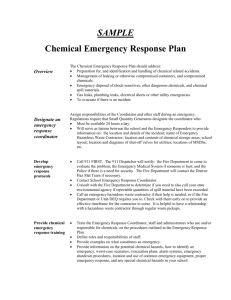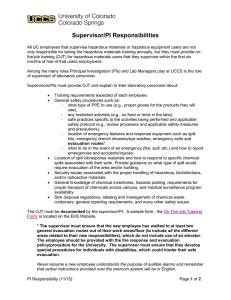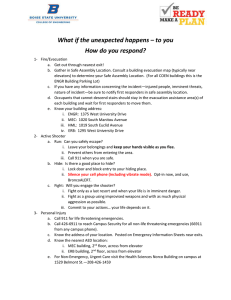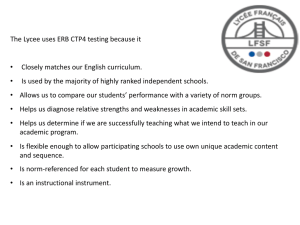ERB 2118 LAB SAFETY MANUAL
advertisement
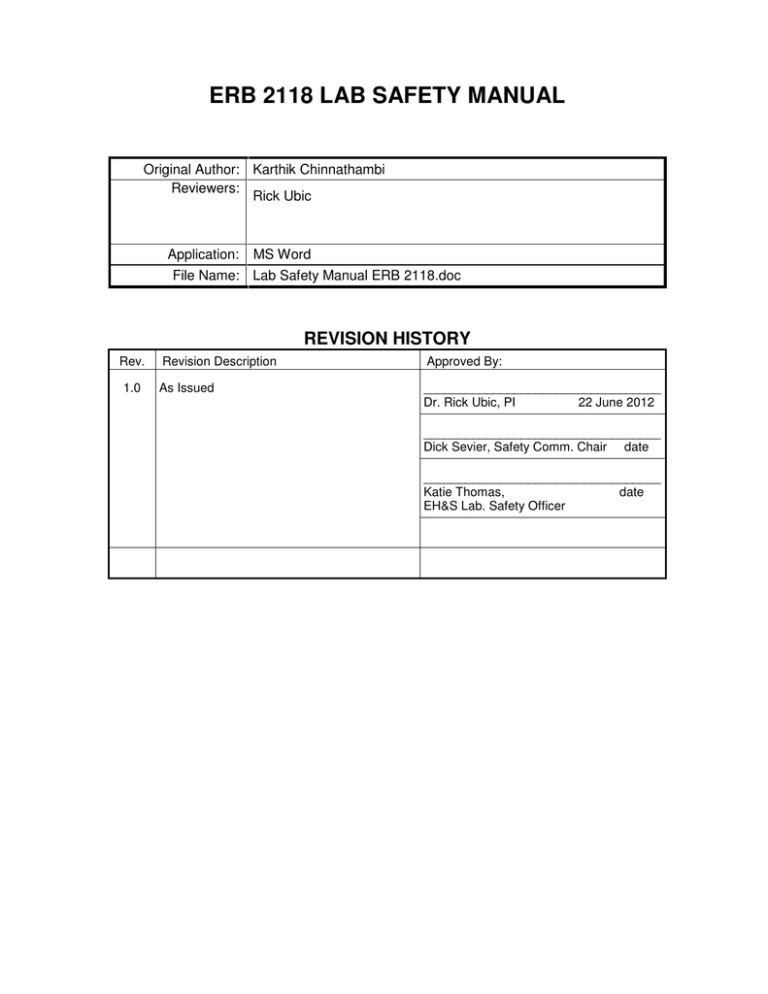
ERB 2118 LAB SAFETY MANUAL Original Author: Karthik Chinnathambi Reviewers: Rick Ubic Application: MS Word File Name: Lab Safety Manual ERB 2118.doc REVISION HISTORY Rev. 1.0 Revision Description Approved By: As Issued __________________________________ Dr. Rick Ubic, PI 22 June 2012 __________________________________ Dick Sevier, Safety Comm. Chair date __________________________________ Katie Thomas, date EH&S Lab. Safety Officer ERB 2118 LAB SAFETY MANUAL TABLE OF CONTENTS 1.0 Scope .......................................................................................................................... 3 2.0 Lab Safety Checklist .................................................................................................. 3 3.0 Emergency Response ................................................................................................ 4 3.1 3.2 3.3 Calling 9-1-1 ................................................................................................................................... 4 COEN Emergency Response Guide .............................................................................................. 5 Secondary Contacts ....................................................................................................................... 5 4.0 Lab Operations and Hazards ..................................................................................... 6 4.1 4.2 4.3 4.4 4.5 4.6 4.7 4.8 Description of Lab Operations ........................................................................................................ 6 Hazards Summary.......................................................................................................................... 6 Stop Work Practice ......................................................................................................................... 6 Personal Behaviors ........................................................................................................................ 6 Personal Protective Equipment (PPE) ........................................................................................... 7 Engineering Controls for Hazards .................................................................................................. 8 Administrative Controls for Hazards ............................................................................................... 8 4.7.1 Lab Signage ........................................................................................................................ 8 4.7.2 Training ............................................................................................................................... 9 4.7.3 Certification ....................................................................................................................... 11 4.7.4 Business Hours ................................................................................................................. 12 4.7.5 Laboratory Safety Notebook(s)......................................................................................... 12 4.7.6 Chemical Ordering ............................................................................................................ 13 4.7.7 Chemical Labeling ............................................................................................................ 13 4.7.8 Chemical Inventories ........................................................................................................ 13 Lab Incidents, Accidents and Property Loss ................................................................................ 13 5.0 Chemical Emergencies ............................................................................................ 14 5.1 5.2 5.3 5.4 5.5 Chemical Contact ......................................................................................................................... 14 Large Chemical Spill .................................................................................................................... 15 Small Chemical Spill ..................................................................................................................... 16 Uncontained Spill Release ........................................................................................................... 16 Spill Investigation Report.............................................................................................................. 17 6.0 Waste Management .................................................................................................. 18 6.1 6.2 6.3 6.4 6.5 6.6 Definition of Waste ....................................................................................................................... 18 Hazardous Wastes ....................................................................................................................... 18 Waste Pickup................................................................................................................................ 18 Illegal Disposal of Waste .............................................................................................................. 19 Segregation of Waste ................................................................................................................... 19 Hazardous Waste Containers ...................................................................................................... 20 7.0 Additional Resources .............................................................................................. 21 7.1 7.2 7.3 COEN Safety Liaison ................................................................................................................... 21 EH&S ............................................................................................................................................ 21 COEN Safety Website .................................................................................................................. 21 Appendix A. Laboratory Evacuation Path .................................................................. 22 Evacuation & Safety Equipment Map- Environmental Research Bldg, 2nd Floor ........... 23 25-Oct-11 Page 2 of 23 ERB 2118 LAB SAFETY MANUAL 1.0 SCOPE This document describes the standard operating procedures and practices encountered and to be practiced in the ERB 2118 lab. Due to the scope of the various activities of the lab regarding chemical usage, processes, and waste generation, this document is not intended to be comprehensive. Instead, it is intended to provide a general overview in defining safe work practices. For general emergency response measures, consult the COEN Emergency Response Guide, which is described in Section 3.2. It is mandatory that all individuals who perform work in lab be fully aware of this document’s existence, understand its contents, and satisfy the testing requirements associated with it. This burden of knowledge, therefore, is the responsibility of both the PI and the individual. 2.0 LAB SAFETY CHECKLIST Below is a checklist of important safety-related information for your lab. Familiarize yourself with this information. See Appendix A for map showing safety equipment locations. Lab Information: Name: Functional Ceramics Rm: ERB 2118 Building Address: 1295 University Dr., Boise, ID 83706 Lab Phone Number: N/A Important Safety-Related Locations: Secondary Contact Info: _X__ On Door _N/A_ Near Phone Lab Safety Notebook: Rack near the exit Nearest Fire Extinguisher: ERB 2nd floor, opposite ERB 2118 Nearest First Aid Kit: In lab Nearest Eyewash/Safety Shower: In Lab Nearest Chemical Spill Kit: under sink next to fume hood Nearest AED- MEC 2nd floor opposite elevator Nearest Fire Alarm Pull: No fire alarm pull in this building Nearest Phone: ERB 2nd floor near elevator Safe Assembly Area For Evacuation: Corner of University and Euclid Meet 1st Responders: on W. University Dr. 25-Oct-11 Page 3 of 23 ERB 2118 LAB SAFETY MANUAL 3.0 EMERGENCY RESPONSE 3.1 Calling 9-1-1 • If possible, get out of immediate danger. • In the event of a fire, or if you feel the building’s occupants are in danger: o Go to the nearest security push button (located by the elevators) to alert University Security OR immediately dial 9-1-1. o Evacuate the building immediately! Refer to Appendix A Laboratory Evacuation Path at the end of this document for additional evacuation information. • To report any police, fire, or medical emergency, call 9-1-1 from any phone. When calling 9-1-1: 25-Oct-11 • Stay on the line with the dispatcher. • Provide the address of the building involved and your exact location if?? calling from a cell phone. • The address of the ERB is: 1295 University Dr. • Provide a thorough description of the incident to ensure that proper resources are dispatched. • Do not hang up until the dispatcher tells you to do so. Page 4 of 23 ERB 2118 LAB SAFETY MANUAL 3.2 COEN Emergency Response Guide The COEN Emergency Response Guide has been designed to provide training to the College’s faculty, staff and students to address an emergency situation. The guide is included in your laboratory’s safety notebook. It can also be accessed from the Safety website on the College of Engineering website. Go to http://coen.boisestate.edu/safety, then click on the COEN Emergency Response link. This guide provides emergency content on the topics below. This material can also be quickly accessed from the COEN Safety website by clicking on a link below: Calling 9-1-1 Emergency Contact Information Natural Gas Leaks Electrical Power Outage Earthquake-Tornado-Flood Fire and Smoke Hazardous Materials Incident Bomb Threat Suspicious Mail Active Shooter Threatening Behavior Work-Related Injury or Illness Life Threatening Condition Using an AED Exposure to Blood or Bodily Fluids COEN ”Handler” Status Line Alert@Boise State Evacuation Procedures Building Floor Maps ENGR 1 – 2 – 3 MEC 1 – 2 – 3 – 4 HML 1 – 2 ERB 1 – 2 – 3 – 4 – 5 3.3 Secondary Contacts After calling 9-1-1 in an emergency situation, or if you have a nonemergency situation, it is important that you inform secondary contacts of the laboratory situation. Secondary contact information is provided on the Emergency Response signage posted on the entrance of the lab. 25-Oct-11 Page 5 of 23 ERB 2118 LAB SAFETY MANUAL 4.0 LAB OPERATIONS AND HAZARDS 4.1 Description of Lab Operations 4.2 4.3 4.4 Hazards Summary Stop Work Practice Personal Behaviors 25-Oct-11 The operations and activities of this lab includes the following: • Fabrication of oxide ceramics for dielectric and energy applications • Chemical synthesis, ball milling and high temperature sintering The hazards of the lab’s operation(s) include the following: • Toxic Chemicals • Flammable liquid • Thermal energy • Mechanical • A worker should never perform a job if she/he believes it to be unsafe or if inadequate PPE is available or sufficient safety measures are in not place. • If a worker feels a job cannot be performed safely, she/he should see her/his supervisor immediately for resolution. • If a worker feels pressured into performing a job they believe to be unsafe, they should contact their PI and/or the COEN Safety Liaison immediately. • Workers must be familiar with the hazards of the materials with which they are working. • No food or drink is permitted in the lab. • No unauthorized experiments. • Personnel must have pre-approval by his/her direct supervisor in order to perform work alone. • Work should not be conducted if the researcher is feeling tired or otherwise impaired. • No rough-housing is permitted in the lab. • When performing an operation, consider if nearby workers require additional protection and take appropriate measures. • Employ good housekeeping rules by maintaining a clean, uncluttered work area. Page 6 of 23 ERB 2118 LAB SAFETY MANUAL 4.5 Personal Protective Equipment (PPE) The information provided below is intended only to provide an overview of PPE requirements. For more detailed PPE requirements of your lab, consult with the procedure documents for those specific processes and/or discuss with your lab PI or supervisor. If you feel you are engaged in a process that places you at risk, it is your responsibility to wear the appropriate PPE, if available, or halt work until the proper PPE can be procured. 25-Oct-11 • Close-toed shoes must be worn in the lab at all times. • Safety glasses or goggles must be worn under the following circumstances in this lab. o When certain chemicals are being handled (refer to MSDS) o By Visitors generally unfamiliar with lab hazards and processes o When there is any foreseeable risk of injury to your eyes. • Lab Safety Coats must be worn when handling chemicals. • It is recommended that approved dust masks be worn when working with coarse, non-hazardous nuisance powders. Contact the COEN Safety Liaison or the Environmental Health and Safety office to discuss options for respiratory protection. • Workers must wear face shields and chemical resistant gloves when working with strong acids, bases or any other chemicals of similar toxicity. • Workers must wear appropriate gloves whenever handling hazardous chemicals. • NOTE: Lab Safety Supply (www.labsafety.com) is a good source for purchasing of and information on PPE. See your laboratory supervisor for information on and proper fitting of PPE. Page 7 of 23 ERB 2118 LAB SAFETY MANUAL 4.6 4.7 Engineering Controls for Hazards Administrative Controls for Hazards 4.7.1 Lab Signage 25-Oct-11 • This laboratory is equipped with an exhaust hood. This hood must be used whenever handling hazardous materials that can become airborne at levels approaching or greater than OSHA limits. This hood is NOT to be used with perchloric acid. • This laboratory is equipped with flammables cabinet and corrosive cabinet. Chemicals must be stored in appropriate cabinets. • It is recommended that all liquid chemicals be placed in secondary containers (e.g., pans) that are capable of holding at least 110% of the volume of liquid held in the primary container(s). • It is mandatory that liquid chemicals be placed in secondary containers when 1) incompatible chemicals are placed on the same surface or 2) when chemicals are placed on a flat surface level with or above a drain. • Acids should be placed in secondary containers. • Incompatible chemicals must always be physically segregated by storing them in separate cabinets and/or secondary containers. • A safety shower and eye wash station are located in the laboratory near the left side of the hood. Administrative controls play an important part of reducing hazard risk when engineering controls alone are not sufficient. Below are administrative controls that are in place for this laboratory. The following information is posted on the laboratory entrance from the main hall. This information is general lab information as well as contact information that can be readily updated as required. • Information relating to the general hazards, PPE, and rules of the lab. • Secondary contact information as described in Section 3.3 Secondary Contacts including CPR and AED certified personnel in COEN. Page 8 of 23 ERB 2118 LAB SAFETY MANUAL 4.7.2 Training Before performing any work in the laboratory, each worker must receive training as assigned by the PI. This training will generally consist of a combination of: • This laboratory safety manual and its appendices • The COEN Emergency Response Guide • General training modules on the EH&S training website 1. Hazardous Chemical Waste 2. Compressed Gases 3. Electrical Safety 4. Hazard Communication 5. Emergency Action Plan 6. BSU Chemical Hygiene Plan 7. Flammable and Combustible Liquids These documents are available online at the EH&E website: https://www.ehetraining.com/boisestate • Specific training relating to tasks performed. This training may include document-based training (procedures) as well as operational hands-on training. • Any other training specified by the PI. Note: The Principal Investigator (PI) is responsible for ensuring all workers within the lab are properly trained. All training records are to be maintained in the Laboratory Safety Notebook(s) as described in Section 4.7.5. In order to undertake the on-line training, you will need to have a "test key." IF you don't already have one, click on the "Don't have a key" link, and then click to continue as a new user. The password you then need to enter on the New User Signup page is COENfunctionalceramics. Enter the other details as requested, and you will be emailed an individual test key. Once you have this, go back to the start and enter the key. Complete all the modules listed as required. If you are already included in your supervisor's lab and there are modules listed above which they do not, request that they include the extra modules just for you (they can do this in the EH&E system). When you are done, print out the web page which shows your test record. At the bottom of that page write the words "I have read 25-Oct-11 Page 9 of 23 ERB 2118 LAB SAFETY MANUAL and understood the contents of the ERB 2118 Laboratory Safety Manual", sign and date the page, then submit it to the laboratory supervisor. There is no need to print out your certificate of completion. • ERB 2118 Laboratory Safety Manual (this document) • Specific training relating to tasks performed. This training may include document-based training as well as operational handson training. The Laboratory PI is responsible for ensuring training materials and processes are maintained. 25-Oct-11 Page 10 of 23 ERB 2118 LAB SAFETY MANUAL 4.7.3 Certification Certification level is determined by the type of work performed or responsibilities held in the lab: 1. A Laboratory Visitor is a person who does not work in the laboratory but is simply visiting. All visitors must be escorted by a laboratory worker. 2. An Support Worker is a person who works periodically to support the facility or IT needs of the laboratory. 3. A Laboratory Guest Worker is a person who works temporarily in the laboratory for a period of ten days or less in a given calendar year. 4. A Laboratory Worker is a person who routinely performs work in the laboratory for a period of more than ten days in a given calendar year. 5. A Laboratory Supervisor is a specific person charged with overseeing activities within the lab. • • Completion of the following training is required for the worker types as shown below: Laboratory Safety Manual EH&S General Training Task Specific Training Laboratory Visitor No No No Support Worker Yes No No Laboratory Guest Worker Yes No As required Laboratory Worker Yes Yes As required Laboratory Supervisor Yes Yes All The Laboratory PI is responsible for ensuring certification records are maintained. Re-certification of workers is required annually or when there has been sufficient content change of the training to warrant recertification as deemed by the Laboratory PI. 25-Oct-11 Page 11 of 23 ERB 2118 LAB SAFETY MANUAL 4.7.4 Business Hours With the exception of official university holidays, the normal hours of operation for the lab are: Monday – Friday 8:00am – 5:00pm Any qualified user is entitled to use the lab during these times. Out-of-Hours Use: The Laboratory Supervisor and qualified Laboratory Workers (as defined in 4.7.3) may use the lab outside these times provided that at least one other person is also present within earshot. No user should be present in the lab on his/her own outside of normal business hours. No work involving chemical solvents, acids, bases, furnaces, or other “dangerous” aspects should be conducted outside of normal business hours. Any users found in violation of this policy will face disciplinary action, including possible exclusion from the lab, at the discretion of the Laboratory PI. 4.7.5 Laboratory Safety Notebook(s) The notebook(s) is intended to provide a variety of safety-related content that can be readily accessed by lab members and visitors to the lab. In general, the notebook will contain: • The lab safety manual, procedures and other training materials • College of Engineering Emergency Response Guide • Current contact information for COEN and BSU safety personnel • Information and forms relating to lab incidents/accidents • Records of safety training for each lab worker (may be located elsewhere but must be readily accessible). • Chemical inventory and MSDSs for lab For more information on how to organize a lab safety notebook, contact the COEN Safety Liaison, Section 7.1. 25-Oct-11 Page 12 of 23 ERB 2118 LAB SAFETY MANUAL 4.7.6 Chemical Ordering 4.7.7 Chemical Labeling 4.7.8 Chemical Inventories • Lab personnel will order all chemicals in accordance with the College of Engineering chemical ordering policy. • This policy is designed to provide guidelines for how chemicals are ordered and delivered to laboratories. • For more information on the policy and the process to be followed, contact the COEN Safety Liaison, Section 7.1. All chemicals, including those stored in temporary storage, must be properly labeled. Do not write over information printed on chemical labels. For temporary storage, include all the information from the chemical inventory list as well as the creation date of the temporary storage. • • 4.8 Lab Incidents, Accidents and Property Loss A chemical inventory of the laboratory is to be performed on a yearly or more frequent basis. The best way to maintain a chemical inventory is to make realtime adjustments as chemicals are ordered or depleted. • Contact the COEN Safety Liaison, Section 7.1, for more information. • The completed inventory is to be printed and stored in the Laboratory Safety Notebook(s) as described in Section 4.7.5. In the event of an incident where a person in the lab is injured, or where property is damaged, contact the Boise State Office of Risk Management and Insurance to ensure the proper measures are taken to protect health and property. Their contact information can be found at: http://rmi.boisestate.edu/. Incidents (and near misses) can also be reported on-line from the link on the EH&S home page: Also, your lab notebook should have the proper forms and a flow chart to describe how to handle an incident for an employee. 25-Oct-11 Page 13 of 23 ERB 2118 LAB SAFETY MANUAL 5.0 CHEMICAL EMERGENCIES 5.1 Chemical Contact • 25-Oct-11 If you are not sure how dangerous the chemical contact is, call 9-1-1. See Section 3.1 Calling 9-1-1 for additional information. • The treatment of a chemical exposure takes precedent over spill cleanup, spill containment, or property damage including water damage from the use of an eyewash or safety shower. • In the event of chemical contact with skin or eye, flush the affected area for a minimum of 15 minutes. Use the nearest safety shower and eye wash station as identified in Section 2.0 Lab Safety Checklist. If possible, obtain assistance to remove contaminated PPE and clothing after flushing has begun. • If contact is made through inhalation, immediately move to a area away from the exposure. • After immediate treatment for the exposure has been completed, contact your supervisor; then call EH&S at 8638024 (24-hr cell) and Security at 426-1453. • Have the MSDS information for the chemical(s) available for reference. This information can be found in the notebook described in Section 4.7.5 Laboratory Safety Notebook(s).If first responders are summoned, meet them at the location described in the Lab Safety Checklist with the MSDS information for the chemical(s) that were contacted. • Contact Boise State Risk Management to complete the proper forms relating to the exposure. See Section 4.8 Lab Incidents, Accidents and Property Loss • Complete a Spill Investigation Report from Section 5.5. Page 14 of 23 ERB 2118 LAB SAFETY MANUAL 5.2 Large Chemical Spill A large spill is a spill greater than 200mL or 200 g OR any amount of an extremely hazardous substance OR beyond the cleaning capabilities or comfort level of the laboratory or laboratory workers. If deemed necessary or you are unsure of spill severity, immediately call 9-1-1. You may also use the emergency push button, located by the elevator, to contact University Security. Otherwise, take the following steps: 25-Oct-11 • If the spill occurs in the fume hood, close the hood sash. • Inform others in the area of the spill. • Turn off any gas burners without putting yourself in harm’s way. • Retrieve MSDS without putting yourself in harm’s way. • Evacuate the area, closing the doors behind you. • Contact your supervisor; then call EH&S at 863-8024 (24-hr cell) and Security at 426-1453. • Post warning outside the area and lock doors if possible to prevent re-entry. • Complete a Spill Investigation Report from Section 5.5. Page 15 of 23 ERB 2118 LAB SAFETY MANUAL 5.3 Small Chemical Spill A small spill is defined as a spill less than or equal to 200mL or 200 g AND not of an extremely hazardous substance AND within the cleaning capabilities and comfort level of the laboratory and laboratory workers. If you are not sure or uncomfortable with the clean up, contact your supervisor and EH&S at 863-8024 for assistance. If EH&S is not available, contact Boise State Security at 426-1453. Otherwise, take the following steps: 5.4 • If the spill occurs in the fume hood, close the hood sash. • Inform others in the area of the spill. • Turn off any gas burners without putting yourself in harm’s way. • Retrieve MSDS without putting yourself in harm’s way. • Review applicable MSDS and determine controls, PPE, and need for assistance. • Put on necessary protective clothing (gloves, safety goggles or glasses, and lab coat). • Cover small spills with absorbent towels or powder absorbent. Clean spill area working from outside toward the center. • Rinse spill area with water. Label and retain spill materials for EH&S. • Contact your supervisor; then call EH&S at 863-8024 (24-hr cell) and Security at 426-1453. • Complete a Spill Investigation Report from Section 5.5. Uncontained Spill A spill or release of chemicals into any drain is an uncontained spill release. Communicate all uncontained spills to a member Release of EH&S at 863-8024 (24-hr cell) so that they can contact the proper authorities. If EH&S cannot be reached, the responding faculty or staff member must report the spill to the COEN Safety Liaison, Section 7.1, or Lander St. Wastewater Treatment Plant: 608-7382 or 608-7380 Boise Department of Public Works Pretreament Contacts Mike Hunter, Senior Environmental Specialist 384-3993 Walt Baumgartner, Pretreatment Prog. Coordinator 384-3991 Terry Alber, Senior Environmental Specialist 384-3992 Also, complete a Spill Investigation Report from Section 5.5. 25-Oct-11 Page 16 of 23 ERB 2118 LAB SAFETY MANUAL 5.5 Spill Investigation Report 25-Oct-11 A Spill Investigation Report form must be completed in the event of a spill or uncontained release of chemicals into a drain. Contact EHS for assistance in completing this form; see Section 7.2, EH&S. Page 17 of 23 ERB 2118 LAB SAFETY MANUAL 6.0 WASTE MANAGEMENT 6.1 Definition of Waste A variety of solid and liquid wastes can be generated in the laboratory. Any lab worker or student that works with chemicals is required to understand how to safely handle, store, and dispose of these materials. Once you determine a material: • cannot be reused, • cannot be used for its intended purpose, • has exceeded its shelf life, • has no known owner or generator, • is no longer wanted or needed, or • is an end product of a process or experiment that cannot be used as feedstock in an existing process, IT IS A WASTE. 6.2 6.3 Hazardous Wastes Waste Pickup 25-Oct-11 • Please remember that maintenance fluids must, in most cases, be disposed of as waste. • Waste classified as Hazardous Waste must be disposed of properly, in accordance with BSU’s Hazardous Waste Management Manual. • If you have any questions regarding whether a waste material is hazardous or how to store or dispose of it, or would like a copy of the Hazardous Waste Management Manual, contact the EH&S Chemical Waste Officer in Section 7.2. • To have waste picked up from your lab, first fill out a Waste Pickup Form. Contact either the COEN Safety Liaison, (Section 7.1) or EHS Hazardous Waste Officer (Section 7.2) for a copy of this form. • E-mail the completed form to EHS Hazardous Waste Officer. • Pickup will typically be done within 5 days of notifying EH&S, depending on storage needs and space availability.If you have any questions regarding how to handle waste, contact either your lab PI or supervisor, COEN Safety Liaison or the EHS Hazardous Waste Officer. Page 18 of 23 ERB 2118 LAB SAFETY MANUAL 6.4 Illegal Disposal of Examples of illegal waste treatment include: Waste 1. Leaving solvent wetted wipes in a hood or on the bench top to air dry. 2. Leaving a container open to allow the waste to evaporate. 3. Pouring an unapproved waste into a drain. 4. Diluting a waste to render it non-hazardous. 5. Venting a pressurized aerosol can solely to remove the propellant. 6. Disposing down the sink or drain without prior approval from EH&S. Consult with the Chemical Waste Coordinator in EH&S before disposing of any chemical down a sink or drain. Contact information is found in previous section. 6.5 Segregation of Waste You must segregate your waste streams. • Keep liquids and solids in separate containers • Keep hazardous and non-hazardous waste in separate containers. You must physically segregate, by secondary containment (separate spill trays, cabinets, etc.), your hazardous waste while in storage from the following: 25-Oct-11 • non-hazardous waste • drains • incompatible waste • product chemicals Page 19 of 23 ERB 2118 LAB SAFETY MANUAL 6.6 Hazardous Waste Containers Hazardous waste containers must be: • sealed/closed to manufacturer’s specifications: o • the only time a hazardous waste container can be open is when you are actively putting waste in the container; and in good condition: o replace deteriorated or damaged containers immediately. NOTE: Make sure you use containers that seal properly, if they leak liquid from the lid when closed, they are considered open containers. Do not use zip-lock bags unless they have a physical means of sealing them to ensure they are sealed. Examples of open containers that are noncompliant are: 25-Oct-11 • zip lock bags not completely sealed; • a Kimwipes cloth caught in the seal of a zip lock bag; • a lid completely off the container; • a lid loose on the container; • the wrong lid on a container; • the container leaks from the lid when sealed properly; • a cracked container; • a pinhole in a bag; and a torn bag. Page 20 of 23 ERB 2118 LAB SAFETY MANUAL 7.0 ADDITIONAL RESOURCES 7.1 COEN Safety Liaison The College of Engineering is staffed with a safety liaison that works closely with COEN labs and the Boise State Environmental Health and Safety team. The safety liaison can also help with chemical ordering, handling chemical waste and many other issues. Contact information for the COEN safety liaison can be found below: Dick Sevier, Research Support Engineer Office: ENGR 332 email: dicksevier@boisestate.edu cell: 286-8175 7.2 EH&S For chemical contact, chemicals spills or other lab emergencies, call the EHS 24 hr cell: 863-8024. The Boise State Environmental Health and Safety (EH&S) team can provide a wealth of information regarding university policy and safety information regarding laboratory work across campus. • Katie Thomas, EHS Hazardous Waste Officer katiethomas1@boisestate.edu ph. 426-3303 Additional information regarding other members of the EHS team, university policy, training, etc is provided on their website site at: 7.3 COEN Safety Website 25-Oct-11 • http://vpfa.boisestate.edu/EHS/ • The COEN Safety website is hosted on the College of Engineering’s website at http://coen.boisestate.edu/safety. • Topics of the website include: o Emergency response information o Commonly used forms and documents o Chemical management, including chemical ordering, chemical inventory and MSDS record-keeping o Lab Safety (PPE, controls, etc.) o Safety training, including types of training, templates, etc. o Calendar of safety-related events Page 21 of 23 ERB 2118 LAB SAFETY MANUAL Appendix A. Laboratory Evacuation Path EVACUATING YOUR BUILDING OR WORK AREA: 1. When ordered to evacuate or when alarms are activated, always leave immediately. 2. Follow path shown by red arrows in the following map to stairwells and descend to first floor exits. 3. Exit quickly and calmly using nearest emergency escape routes and marked exits and proceed to safe assembly locations as identified in the building maps of this section. 4. Do not use elevators. 5. Be alert for those persons needing assistance. See EVACUATION ASSISTANCE below. 6. During an evacuation, faculty, staff and students will generally go to the safe assembly area. 7. If your or members of your lab have specific information relating to the incident, ensure you meet first responders at the location defined in Section 2.0 Lab Safety Checklist with appropriate lab documentation (MSDSs, chemical inventory, etc.). 8. Be alert for trapped, injured or other persons needing assistance. a. Help those requiring evacuation assistance get to designated areas for evacuation assistance. Transporting of individuals requiring evacuation assistance up or down stairwells shall be avoided until emergency responders arrive unless an imminent life-threatening condition exists. b. Notify emergency responders immediately upon their arrival of the exact location of any injured or trapped persons, and those waiting in designated areas for evacuation assistance. Do not return to an evacuated building unless directed to do so by authorities. EVACUATION ASSISTANCE 1. Be alert for mobility-impaired, trapped, injured or other persons needing assistance. 2. On second or higher floors, assist persons requiring assistance to get to a designated Evacuation Assistance Area. These areas are identified in map on following page. 3. Transporting of individuals requiring evacuation assistance up or down stairwells shall be avoided until emergency response personnel have arrived. Unless imminent life-threatening conditions exist, relocation of these individuals shall be limited to the designated Areas for Evacuation Assistance. 4. Notify emergency personnel immediately upon their arrival of the exact location of any injured or trapped persons, those waiting in designated Evacuation Assistance Areas and any others who may be anywhere in the building. 25-Oct-11 Page 22 of 23 ERB 2118 LAB SAFETY MANUAL EVACUATION & SAFETY EQUIPMENT MAP- ENVIRONMENTAL RESEARCH BLDG, 2ND FLOOR Safe Assembly Location: Corner of University & Euclid N Fire Extinguisher AED- MEC 2nd Floor, Opposite Elevator Emergency Phone Evacuation Assistance Area Note: There are no fire alarm pulls in this building. 25-Oct-11 Page 23 of 23

